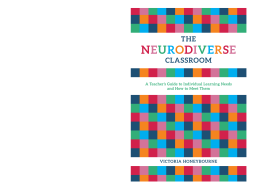
Additional Information
Book Details
Abstract
With specific learning difficulties more prevalent than ever in mainstream schools, this is the essential guide for teachers wishing to create inclusive and successful learning environments in diverse classrooms. Focusing on promoting acceptance and self-esteem of each child rather than on labelling their difficulties, it shows how to make good use of simple resources and meet a wide range of needs, including children with ADHD, autism, OCD, dyslexia and special speech and language needs.
The practical advice and strategies in this book enable schools to become more accepting places for all pupils, and embrace neurodiversity as the new 'normal' in education today.
A refreshing new approach to neurodiversity within the classroom. Victoria Honeybourne supports the notion of teaching all students as individuals and not categorising them by the 'labels' that some have for their learning difficulties. All students have strengths and weaknesses and there is no one 'correct' way of teaching for all. The book gives useful ideas, advice and checklists and is a stimulating and thought-provoking resource for all involved in education.
Dr Diana Hudson, author of Specific Learning Difficulties - What Teachers Need to Know
Victoria Honeybourne has written an innovative book which presents new ways of approaching individual needs and inclusion in schools. It is a thought-provoking book emphasising the benefits of embracing neurodiversity and celebrating difference. Victoria clearly describes how to implement a whole school approach to promote positive attitudes to neurodiversity, and provides practitioners with a wealth of easy-to-use resources and strategies. This book will help practitioners who are struggling to cope with the wide range of needs presented by the pupils in their class and enable them to learn and thrive.
Joy Beaney, teacher, autism specialist and author of Winston Wallaby Can’t Stop Bouncing and Creating Autism Champions
Victoria Honeybourne is a writer, trainer and senior advisory teacher in the field of special educational needs. She is the author of A Practical Guide to Happiness in Children and Teens on the Autism Spectrum.
Victoria Honeybourne's The Neurodiverse Classroom is a groundbreaking book. This book will have an impact on the reframing of classroom practice and creating successful and fully inclusive schools - moving from the rhetoric to the reality.
Clearly organized and well-written, this is a superb book for all educators. The term 'neurodiversity' is clearly explained and Honeybourne, using her personal and vast professional experience, provides practical arguments as to why a paradigm shift in inclusion is needed. As she indicates, 'neurodiversity' should be accepted and celebrated. This a positive book with a persuasive message. It will, and certainly should, become a popular book for those entering the profession and for experienced practitioners. There are many practical strategies contained within comprehensive coverage of the challenges experienced by children with learning differences and how these can be overcome. An exciting, thought-provoking and practical book.
Dr Gavin Reid, Practitioner Psychologist and author of Dyslexia in the Early Years
Table of Contents
| Section Title | Page | Action | Price |
|---|---|---|---|
| The Neurodiverse Classroom: A Teacher's Guide to Individual Learning Needs and How to Meet Them by Victoria Honeybourne | 3 | ||
| About This Book | 9 | ||
| 1. Introducing Neurodiversity | 13 | ||
| 2. Understanding Neurodiversity | 32 | ||
| 3. Communication | 56 | ||
| 4. Getting the Environment Right | 82 | ||
| 5. Teaching and Learning | 101 | ||
| 6. Student Wellbeing | 127 | ||
| 7. Working with Home | 150 | ||
| 8. Whole School Approaches | 161 | ||
| Abbreviations | 178 | ||
| Further Resources | 180 | ||
| References | 184 | ||
| Index | 187 | ||
| Blank Page |
